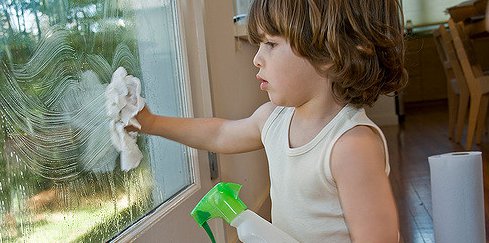One of the major advantages of a uPVC window frame over timber is that it’s robust and long-lasting and requires minimal maintenance. While wood is naturally porous, uPVC is slippery at a molecular level. Consequently, it doesn’t require regular treatment with sandpaper and a pot of glossy finish. What uPVC windows do require, however, is occasional cleaning. Happily, this doesn’t take long, and will make a major difference to the way the windows ultimately look.
The Wrong Way to Clean uPVC Window Frames
uPVC is inherently vulnerable to certain sorts of mistreatment. It’s therefore worth pausing to think about what we shouldn’t be doing under any circumstances.
The surface of a plastic window frame is glossy and smooth, but scratch beneath the surface and the material is really dull. You can’t put uPVC back on once you’ve rubbed it off, and as such caustic cleaning agents and harsh scrubbing brushes are to be avoided. Even paper towels can be abrasive if used repeatedly.
Bleach should never be used on uPVC window frames, as it’ll discolour them. Unless you’d like your pristine white frames to turn an unsightly shade of brown, avoid it. Even small doses will cause a chemical reaction with the glossy surface of the plastic, creating a dull matt effect that can never be undone. Cellulose thinners are another item to avoid – they melt plastic, and will ruin your window almost instantly.
The Right Way to Clean uPVC Window Frames
The right approach is a gentler one. Ordinary soap and water, applied with a sponge or a soft cloth, will be enough to shift most stains. If you’re pressed for time, you might give the sill a once-over with a wet-wipe.
Alternatively, you can use a homemade solution, or a specialist chemical solution that has been formulated just to tackle uPVC.
Natural uPVC Cleaner
If you’d rather not spend your money on washing powder and wet-wipes, then why not consider a natural alternative? By mixing one-part vinegar with one-part hot water, you’ll create an acidic solution that can be applied easily using a spray bottle. You won’t need much to get the job done, and the acids won’t react with the uPVC in the same way that bleach will – just spray on a little bit and allow the solution to lift the stains away from the plastic. This will take around ten minutes.
After 10 minutes, wipe it clean – the dirt should lift off instantly. Don’t allow the moisture to sit there, or you’ll attract mildew. Once you’re done, you should be looking at a sparkling clean uPVC window frame.
Ready to replace your windows? Shop for sliding sash, casement, or made to measure windows.


